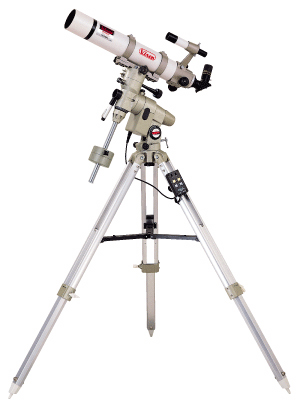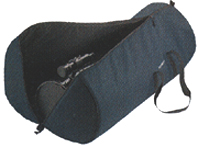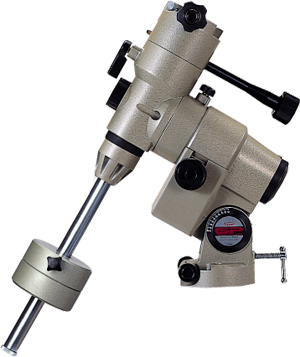Vixen Distribution
![]() History
History ![]() News
News ![]() Notes & Literature
Notes & Literature ![]() Overview
Overview ![]() Pricing
Pricing ![]() Products
Products
![]() Mounts
Mounts
![]() Telescopes
Telescopes
![]() Quality Control
Quality Control
![]() Service or Repair
Service or Repair

VIXEN GREAT POLARIS "GPE" GERMAN EQUATORIAL MOUNT
"the best lightweight German equatorial mount worth keeping..."
Right: Vixen GPE German equatorial mount head shown as provided with no other accessories (52,788 bytes)
Click on the image to see enlarged view (79,415 bytes).
![]() Overview: What is the GPE and when do we recommend it?
Overview: What is the GPE and when do we recommend it?
The GPE is one of the most economical of the three "Great Polaris" series German equatorial mounts manufactured by Vixen Co., Ltd. The other model GP mounts include the similar but more accessorized GP model, and another which is similar in appearance to the GP but is its beefed up cousin the GPDX. The GP series are the descendants of the Vixen "Super Polaris" mounts which came to dominate the 1980's. In the USA the Super Polaris were distributed under the Celestron trademark, while the heavier duty "Super Polaris DX" was imported for a couple of years by Astro-Physics. The Great Polaris are an improved, modular German equatorial mount system where the customer is allowed to tailor the system to their particular needs choosing from a broad selection of accessories. There has been some effort to reduce the initial cost of the current GPE's by making some items optional which used to be included: Field Tripod, R.A. and Decl. Setting Circles (which were rarely used anyway) and the 6x 20 mm Pole Alignment Finder telescope. Refinements include a Dovetail Plate hardware mechanism to facilitate the quick interchange of payloads, a better selection of tripods and electronic drive systems.
The now discontinued Super Polaris mount has been "cloned" by factories in third world nations. Some of these clones including the Orion SkyView™ offered by Company Seven have become quite accepted for very basic visual uses, and these can provide a good value particularly when one considers their cost is about half that of a complete GPE. However, the GP series mounts have not yet been equaled in performance or refinement by these knock offs. The GP mounts provide a superior selection of better engineered options. The GPE provides better rigidity pound per pound and weigh less than the clones due to the use of advanced materials, better components and design. And the GP mounts incorporate more precise tracking gear and bearing sets with smoother manual geared controls than those provided with the mounts made by imitators; this is particularly apparent to those who observe in below freezing environments.
The choices of electronic drive systems are better for the GP than those available for other mounts at or below the cost of the GP mounts. And over time the GP mounts will require less maintenance and perform even better as the cheaper, grease packed mounts accumulate debris or the lubricants which help to make them perform well when new age and congeal.
Company Seven recommends the GP to accommodate payloads including:
- cameras for wide sky astrophotography or sky survey applications,
- telescopes weighing up to about 15 lb.. / 7 kg, this can include
- Refracting telescopes up to about 100 mm aperture *
- Reflecting telescopes up to about 200 mm *
- Catadioptric telescopes of up to about 200 mm *
* there are factors acting upon a German mount affecting its suitability including: payload weight and length (torque), payload area and profile exposed to winds, desired tracking accuracy, tripod or pier resonance's, etc. What are most important to the user is how rigidly the mount holds the payload, how smoothly it tracks (amplitude and smoothness of the periodic error of a gear), and how well it overcomes the moment imparted by the load. The final operating weight put onto a mount can also depend on how the instrument is to be accessorized.
If you seek to buy a good basic German equatorial mount which can provide a lifetime of service, and which can is deserved particularly for visual applications with a better quality telescopes (Astro-Physics 105 'Traveler', TeleVue NP101 and 102, etc.), then the cost of the GPE can be readily justified. The GP is the least expensive mount that can manage these telescope well for most common visual and light duty astrographic applications. For those who observe from wind prone locations, or for those who intend to become involved in longer time exposure astrophotography or CCD imaging then we suggest you consider one of the following mounts because of their more sophisticated electronics, and even better weight bearing and tracking performance:
The GP and GPE mounts are provided only with the Mount Head with Quick Release Saddle,
Below Right: A complete Vixen
A complete GPE mount system will usually consist of these components:
Company Seven offers a number of third party accessories for the GP/GPDX mounts. These include Digital Setting Circle with Encoder sets, or optional fitted Carrying Bag (sample shown at right) which can provide for safer, and more convenient transport the mount with tripod attached. Keep in mind that these are very convenient and padded lightweight bags however, these are not suitable for shipping a telescope or mount. Company Seven do offer rather costly buy sometimes necessary Airline Transport Association approved shipping cases for these products which are suitable for check in on aircraft, or shipping by common carriers.
Please visit Company Seven's showroom to see examples of these Vixen systems firsthand. Or you may Contact Company Seven for help putting together a system for you.
Vixen GPE Optional SD-1 Electronic Drive Specifications
Vixen GPE Optional DD-1 Electronic Drive Specifications
* may exceed range of some batteries
Specifications and availability subject to change
The SD-1 Drive Controller for the GPE/GPDX mounts operates from 9 volt DC power sources, it is provided with a cluster battery holder for six alkaline "C" cell batteries, and power cord. For convenience it is probably best to keep feeding the SD-1 the provided battery pack as it needs them. For operations in below freezing conditions then we recommend you keep the battery pack for the SD-1 in a warm area, possibly in a coat pocket when working near the telescope. Otherwise you may use more costly lithium batteries which perform better at lower temperatures.
The DD-1 Drive Controller for the GPE/GPDX mounts is provided with a cluster battery holder for eight alkaline "D" cell batteries, and power cord. The DD-1 and other common telescope powered accessories (Kendrick Dew/Frost Prevention System, CCD cameras, etc.) require a 12 volt D.C. power source. If you prefer a longer life or more cost effective power supply then Company Seven suggests the user consider one of these following options:

8 Degree Actual Field of View, alignment to within 3 minute accuracy possible
Right Ascension Setting Circle - 10 Minute increments
Declination Setting Circle - 2 Degree increments
Single Axis:
Dual Axis:

![]() GPE Features and Specifications
GPE Features and Specifications
Vixen GPE Mount Head Specifications
![]() Drive System Power Requirements, Sources
Drive System Power Requirements, Sources
Contents Copyright 1994-2004 Company Seven All Rights Reserved



